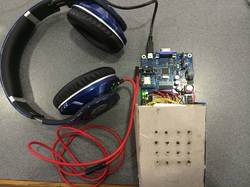Project 20

TITLE: Pattern recognition using LDRs
Description:
Project entitled "Pattern recognition using LDRs" is an mp3 player that can be controlled by making patterns using your finger on the control pad. This was my teammate Craig's idea to implement this project. We used propeller BOE which houses an 8 core processor. We used each core to detect patterns on each row, Two cores to access the SD card and one core to run the main function.
While working on this project we were struck at deciding a smart way to recognize the pattern. We planned to use bruit force method but it consumes lot of memory and is not robust and reliable. I came up an algorithm which read all the sensors and saves their status(1 or 0) in an array as elements. Now, we compute a number which is sum of the products of the elements with square of its indices. By following this method, we compute a value that has highest probability to be unique.
Results:
So, when ever the user makes a pattern, a unique number is generated. We used a switch case for each pattern that we are interested and assigned a task for each case. Thereby, we the user makes a pattern the corresponding action is performed for example, volume up, down, play, play next, etc. We presented this project in the Research expo at NYU to represent the project of Advanced mechatronics class.
References:
Team:
Craig
Parth
Santosh
Description:
Project entitled "Pattern recognition using LDRs" is an mp3 player that can be controlled by making patterns using your finger on the control pad. This was my teammate Craig's idea to implement this project. We used propeller BOE which houses an 8 core processor. We used each core to detect patterns on each row, Two cores to access the SD card and one core to run the main function.
While working on this project we were struck at deciding a smart way to recognize the pattern. We planned to use bruit force method but it consumes lot of memory and is not robust and reliable. I came up an algorithm which read all the sensors and saves their status(1 or 0) in an array as elements. Now, we compute a number which is sum of the products of the elements with square of its indices. By following this method, we compute a value that has highest probability to be unique.
Results:
So, when ever the user makes a pattern, a unique number is generated. We used a switch case for each pattern that we are interested and assigned a task for each case. Thereby, we the user makes a pattern the corresponding action is performed for example, volume up, down, play, play next, etc. We presented this project in the Research expo at NYU to represent the project of Advanced mechatronics class.
References:
- Lecture notes
Team:
Craig
Parth
Santosh
Click here for videos

